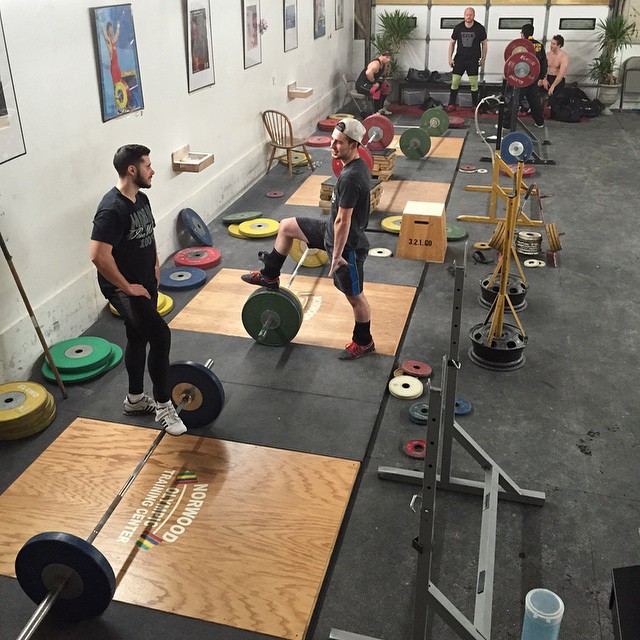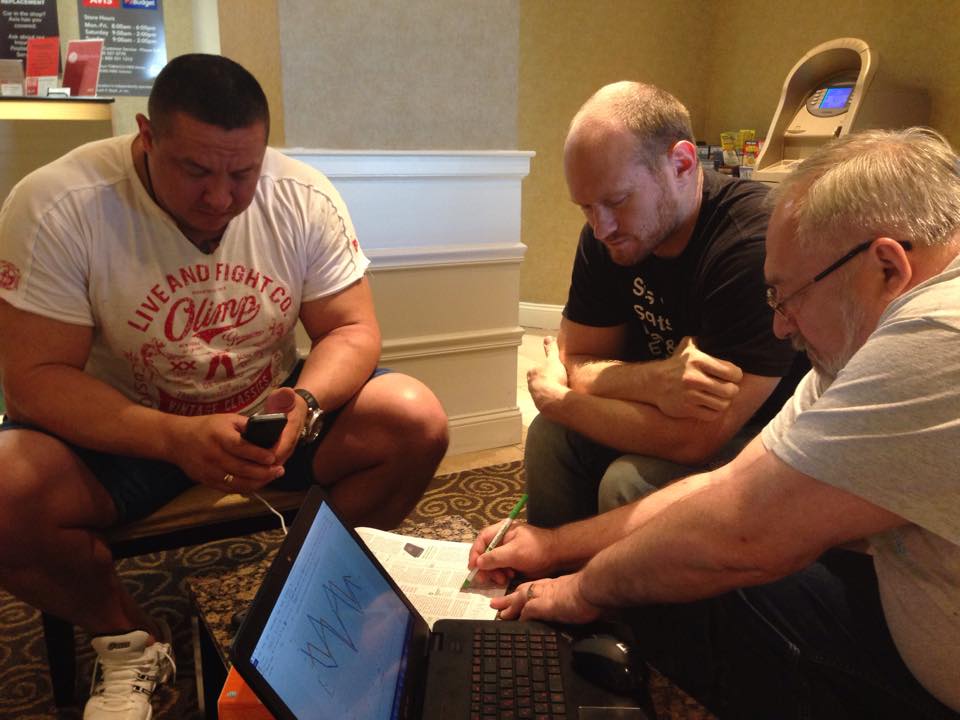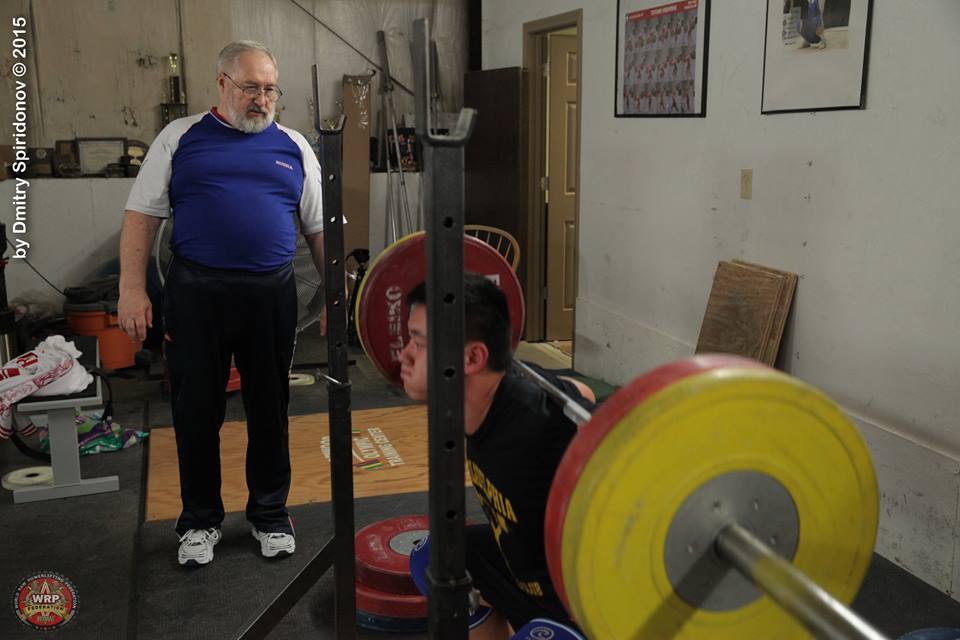NTC (Norwood Training Center) has been my second home for the past 11 years. This weightlifting gym has almost everything a weightlifter could want: the best equipment, great coaching, an open-gym format where lifters can train at any time and follow any program, and friendly, hardworking athletes.
In 2012, Vasiliy Polovnikov moved to Boston for a few months to train at NTC. After his first training session, he told me the environment there was all wrong. He said he didn’t feel safe lifting with people walking in front of him, or standing too close to the platform. He wasn’t able to concentrate when lifters talked to him between sets, or with random, distracting noises that could be heard while he was lifting.
A gym can either be a place where people come to lift weights and socialize (which is fine), or, a gym could be an environment designed to develop successful athletes.
The folks at NTC decided to go with the latter, so we set a few ground rules:
- Come to the gym to work hard, not to socialize.
- Never walk in front of or next to anyone who is lifting.
- Keep quiet when anyone is lifting heavy.
- Clean up after yourself and respect the gym and equipment.
Within a week of setting these new rules, the gym became a weightlifting factory. Workouts got better, everyone was training harder. There was less socializing, everyone became more disciplined, dedicated, and happier with the new environment.
***
Seeing the positive changes that took place at NTC after we set basic rules, I thought it would be interesting to write a post about gym rules in general. I asked several of the most successful coaches in the world what rules they use in their own gyms (if any are established in the first place).
The list of rules I got back differed from coach to coach, but they all followed the same principles:
1. Successful coaches have full control over their athletes training process.
2. Their rules are designed to create the most optimal environment for their athletes to succeed.
Boris Sheiko is the first coach whose rules I’d like to share. I will write about what other coaches said in future posts.
I’ve mentioned Sheiko in past posts. He was the head coach of the Kazakhstan Junior and School Age Weightlifting team, and is the most decorated powerlifting coach of all time. Sheiko has developed 39 world champions. There’s no denying that his process works.
Below are the rules that Boris Sheiko has set up at his gym in Ufa, Russia.
- Greet everyone when entering the gym.
- Athletes are only allowed to train by my plan. Those who choose not to train by my plan can go train at another gym.
- Weights above 80% may only be lifted under my supervision. An athlete must warn me if he is loading 85% or 90% onto the bar so I can observe the lift.
- If an athlete approaches 90% or higher, the entire gym must watch and give their support.
- If a lift is done with ease, I can increase the weight above what’s planned. If the athlete doesn’t handle that weight, the weight is reduced and the athlete should continue the reps and sets that were planned originally.
- If an athlete asks for my permission to lift more than what’s planned, I allow it but warn him that if he doesn’t lift it, he’ll be given a penalty of 2 sets. For example, let’s say the plan is to lift 4 sets of 2 at 85%. If after the first set, the athlete says, “it’s light, I want to add 5kg,” I allow it with the agreement that he lifts it for the remaining 3 sets as written in the plan. If unsuccessful for a single set, he must go down to the planned 85%, and do the remaining 3 sets plus 2 additional penalty sets. However, if the athlete is successful with the heavier weight for the remaining sets, he is crowned “best weightlifter of the gym” for the day.
- If an athlete performs an exercise with incorrect technique, for instance not squatting to or below parallel, the set is not counted.
- During the final training session before a competition, I discuss with the athlete what weight he will open with at the competition. Together we write the warm up weights, sets, and reps.
- During competitions I don’t allow my athletes to look at the protocol (lifts others have done or will attempt). Tactics are the job of the coach. I assign the weights, the athlete lifts them. I watch all of the competitors and psychologically prepare my lifter for the deciding, winning attempts.
- When a workout is complete, athletes must clean the area where they were training.
- Steroids may never be used or discussed in my gym.
- When an athlete is leaving the gym, they must say goodbye to everyone.* Coach Sheiko later added that there were additional unwritten rules which are simply part of the weightlifting culture in general. These include rules for safety, respect for each other, the coach, the gym, and the equipment.
These rules are for Sheiko’s gym. His goal is to develop great athletes, and his rules are designed with that concrete purpose in mind. Most gyms I’ve been to don’t have rules designed for developing successful athletes. At the same time, most gyms don’t repeatedly produce champions, nor is that their goal. Gold’s Gym wouldn’t need to follow these, neither would most standard fitness gyms.
The above rules enforce team comradery, discipline, cleanliness and safety, and most importantly, they push athletes to succeed.
I never thought that weightlifting gym rules were important or interesting. However, seeing that successful coaches have designed rules that aid them in their goals, my thoughts on this have changed. Does your gym have rules that help develop a strong team and successful athletes? If not, would you consider designing rules around the goals of your gym? I’d love to hear from you.










I remember, the halycon days of norwood weightlifting! The gym was quiet and everyone was serious and had efficient workouts.
I would love to somehow get a notification when the next weightlifting gym rules article comes out. I trained as graduate student and athlete at East Tennessee State University where there is an Olympic Training Site for weightlifting under Dr. Mike and Meg Stone. The rules there were similar there, and I now run a facility that will soon be implementing some of our own. Would love to read the next article.
It will be a while until I post about rules again. I want to collect more rules from coaches around the world to put together something real cool. If you or anyone would leave a list of rules (ones actually enforced for some time) here that would be very helpful.
Please do! I’m working on starting a gym for serious trainers under the open gym format. Get in, work, get out, no a “sewing circle” atmosphere.
Yes, at Empire Strength we have very similar rules. Although I allow some members to use their own plan, everyone must have a plane reviewed and approved by me. We try to minimize socializing, but its’s difficult. So I let that one slide a bit…unless it disrupts the tempo of someone’s training…then I step in “be quiet, back to work!” or “stop talking, lift that right now!”
I like the rule about telling me when the bar is 85% or more…I’ll start that today.
A few weeks ago I applied these rules to my barbell club in Brooklyn, NY. The changes took a few sessions to take hold, but the environment is very different now. Every lifter is incredibly positive and focused. They enjoy their training because they are getting what they need and want out of it. Which is results. I would be interested in hearing why anyone would think implementing a system of any kind would not be connected to positive results.
THANK YOU for this article. I shared it with some of my lifting team mates who are new to lifting. I think I will print your article and tape it to the gym wall.
Clean up after yourself (and, if you have to, other patrons). Related to the previous point, if you still manage to sweat through your towel or for some other reason leave sweat on a piece of equipment, grab some paper towel and disinfectant spray (hopefully your gym has some around — if not, hassle them about it) to do your fellow gym-goers a solid. And if you happen to approach a bench of piece of equipment that has some gross droplets of on it already, it won’t kill you to wipe them up yourself. (Though, shame on that other gym rat for being so disgusting.) 7. Selfies: Try to be discreet about them. Look, we know you want to take them and you should be able to. If nothing else, they’re a good way to track your progress. But there are limits. Keep it to the change rooms or on less busy days when you’re not getting in the way of other patrons. The general rule of thumb here is: do what you want — just don’t infringe on anyone else’s gym experience.
cialis cheapest generic cialis cialis 20 mg
I would like to thank you for the efforts you have put in penning this website. I really hope to view the same high-grade blog posts by you later on as well. In truth, your creative writing abilities has motivated me to get my own website now
erectile dysfunction pills universal drugstore online pharmacy
discount pharmacy card pharm pharmacy in canada
canada pharmacy reviews peoples pharmacy pharmacy express
board of pharmacy drug rx people’s pharmacy
Highly descriptive post, I loved that a lot. Will there be a part 2?|
Local Law 196 is a NYC DOB law that requires workers and supervisors at most NYC construction sites to obtain a SST card by completing specific courses through a NYC DOB approved training provider. Able Safety offers multiple packages to complete this training at great low prices. All our SST classes can be completed entirely online from any device (phone, tablet, pc/mac). The NYC DOB’s SST compliance deadline was originally set for September 1st 2020. The deadline has since been extended to March 1st 2021. By this date you will need the following to be allowed to work on most construction sites in NYC.
Local Law 196 is a NYC DOB law that requires workers and supervisors at most NYC construction sites to obtain a SST card by completing specific courses through a NYC DOB approved training provider. Able Safety offers multiple packages to complete this training at great low prices. All our SST classes can be completed entirely online from any device (phone, tablet, pc/mac). The NYC DOB’s SST compliance deadline was originally set for September 1st 2020. The deadline has since been extended to March 1st 2021. By this date you will need the following to be allowed to work on most construction sites in NYC.
Local Law 196 is a NYC DOB law that requires workers and supervisors at most NYC construction sites to obtain a SST card by completing specific courses through a NYC DOB approved training provider. Able Safety offers multiple packages to complete this training at great low prices. All our SST classes can be completed entirely online from any device (phone, tablet, pc/mac). The NYC DOB’s SST compliance deadline was originally set for September 1st 2020. The deadline has since been extended to March 1st 2021. By this date you will need the following to be allowed to work on most construction sites in NYC.